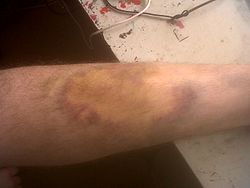Treatment
Care for a soft tissue injury depends upon the structures that have been injured and the degree of injury. Non-surgical interventions become less effective with the amount of damage or tearing, with complete tears often requiring invasive surgical repair. For most injuries, it is recommended to have an initial period of rest and unloading of the injured part for one to three days, followed by gradual increase in structural load. [6] Many injuries have more specific treatments based upon the damaged muscle, such as shockwave therapy and injections of corticosteroid and saline solutions. [6]
A medical professional should evaluate painful injuries and changes in soft tissue function. [7] To make a full diagnosis, they may use nerve conduction studies to localize nerve dysfunction (e.g. carpal tunnel syndrome), assess severity, and help with prognosis. Electrodiagnosis also helps differentiate between myopathy and neuropathy. Magnetic resonance imaging is most commonly used to evaluate soft tissue injuries that may require surgical repair. Immediately following injury, the damaged tissue is often cooled, with some people choosing to continue cooling as a regular part of healing. In recent years, the use of cryotherapy in soft tissue injury management has been challenged extensively. [8] [9] Cooling minimizes the inflammatory process and edema, which is believed to help one recover from a soft-tissue injury. [10] However, prolonged usage of cooling slows healing in animal models. [11] Instead, cooling should be restricted to within 24-48 hours of the injury. [12] However, creatine kinase-MB isoform and myoglobin levels circulating in the blood are increased after exercising. Excessive cooling may impede the recovery process by keeping the Creatine kinase-MB isoform and myoglobin levels increased 2–3 days post exercise. [13] When possible, the affected limb is elevated above the level of the heart, and is compressed using adhesive tape. Evidence supporting elevation and compression is weak, but continues to be widely practiced. [14]
